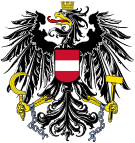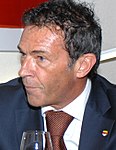1999 Austrian legislative election
| |||||||||||||||||||||||||||||||||||||||||||||||||||||||||||||||||||||||||||||
All 183 seats in the National Council 92 seats needed for a majority | |||||||||||||||||||||||||||||||||||||||||||||||||||||||||||||||||||||||||||||
|---|---|---|---|---|---|---|---|---|---|---|---|---|---|---|---|---|---|---|---|---|---|---|---|---|---|---|---|---|---|---|---|---|---|---|---|---|---|---|---|---|---|---|---|---|---|---|---|---|---|---|---|---|---|---|---|---|---|---|---|---|---|---|---|---|---|---|---|---|---|---|---|---|---|---|---|---|---|
| Turnout | 4,695,225 (80.42%)[1] | ||||||||||||||||||||||||||||||||||||||||||||||||||||||||||||||||||||||||||||
| |||||||||||||||||||||||||||||||||||||||||||||||||||||||||||||||||||||||||||||
| |||||||||||||||||||||||||||||||||||||||||||||||||||||||||||||||||||||||||||||
| This article is part of a series on the |
| Politics of Austria |
|---|
 |
Parliamentary elections were held in Austria on 3 October 1999.[2]
Although the Social Democratic Party remained the largest party in the National Council, a right-wing coalition government was formed by the Freedom Party of Austria (FPÖ) and the Austrian People's Party (ÖVP) after several months of negotiations. Although the FPÖ had finished a fraction of a point ahead of the ÖVP in the popular vote, ÖVP leader Wolfgang Schüssel became Chancellor rather than controversial FPÖ leader Jörg Haider. Haider, who had also been elected Landeshauptmann of Carinthia, was not appointed to the cabinet and resigned as party leader.[3]
However, foreign governments remained critical of the FPÖ's inclusion in the government and the fourteen other member countries of the European Union imposed sanctions on the country, whilst domestically the government faced protests organised by the SPÖ and Greens.[3] However, this pressure on the government helped stabilise it and when it became clear that the FPÖ was not going to be excluded from government, sanctions were lifted.[3]
Voter turnout was 80.4%.[4]
Results
| Party | Votes | % | Seats | +/– |
|---|---|---|---|---|
| Social Democratic Party | 1,532,448 | 33.2 | 65 | –6 |
| Freedom Party of Austria | 1,244,087 | 26.9 | 52 | +11 |
| Austrian People's Party | 1,243,672 | 26.9 | 52 | 0 |
| Green Alternative | 342,260 | 7.4 | 14 | +5 |
| Liberal Forum | 168,612 | 3.6 | 0 | –10 |
| The Independents | 46,943 | 1.0 | 0 | New |
| Communist Party of Austria | 22,016 | 0.5 | 0 | 0 |
| No - Civic Action Group against the sale of Austria | 19,286 | 0.4 | 0 | 0 |
| Christian Electoral Community | 3,030 | 0.1 | 0 | New |
| Invalid/blank votes | 72,871 | – | – | – |
| Total | 4,695,225 | 100 | 183 | 0 |
| Source: Nohlen & Stöver | ||||
References
- ^ "Nationalratswahl 2013 - Endgültiges Gesamtergebnis". Website of the Austrian Ministry of the Interior (in German). Bundesministerium für Inneres. Retrieved 7 November 2014.
- ^ Dieter Nohlen & Philip Stöver (2010) Elections in Europe: A data handbook, p196 ISBN 978-3-8329-5609-7
- ^ a b c Nohlen & Stöver, p179
- ^ Nohlen & Stöver, p217






